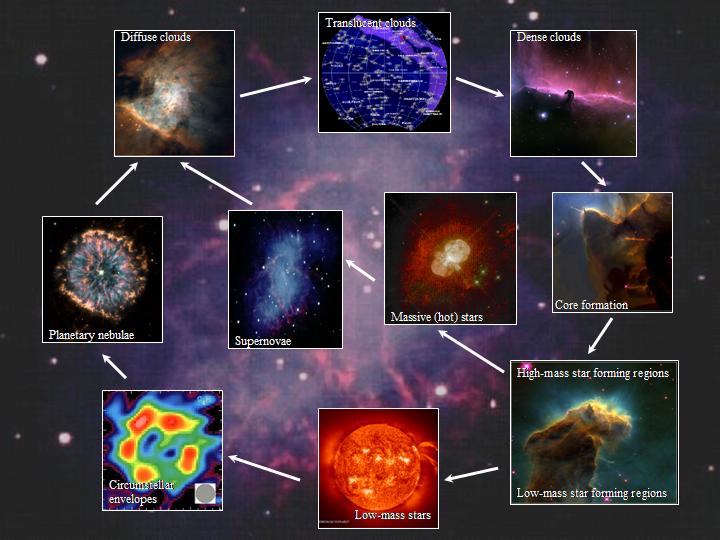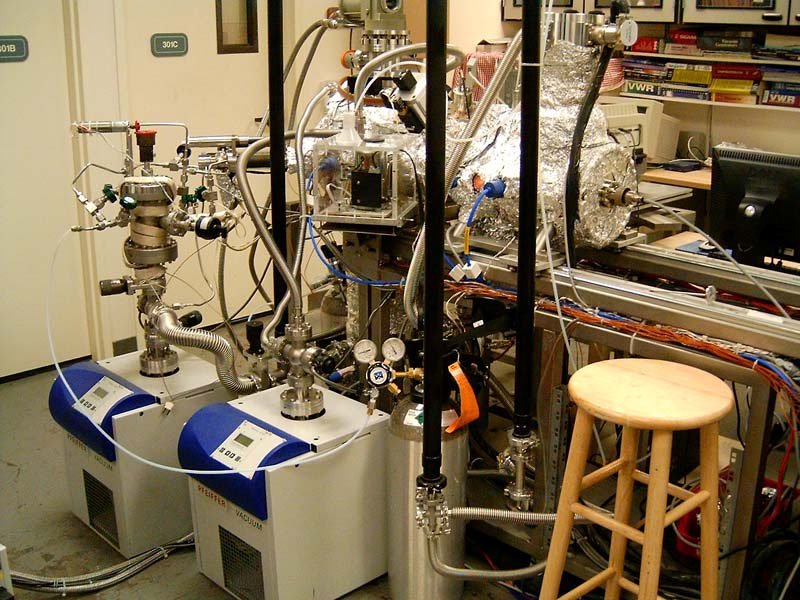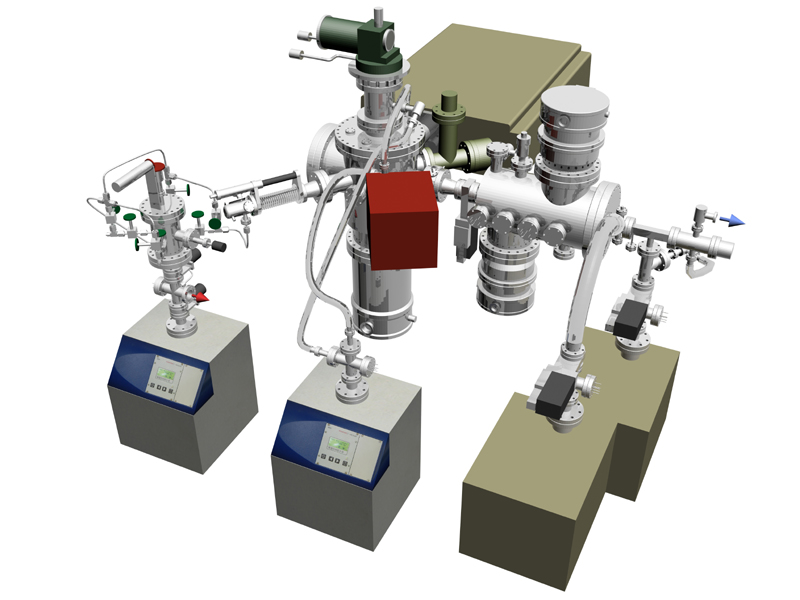The physical and chemical processes leading to the formation of molecules in extraterrestrial environments fascinated scientists since the first detection of CH, CH+, and CN radicals in diffuse clouds 60 years ago. Although more than half a century passed by, and about 200 species from molecular hydrogen (H2) to polyatomics like the sugar glycolaldehyde (HOCH2CHO), benzene (C6H6), and cyanopentaacetylene (HC11N) have been identified so far, the enigma ‘How do these molecules actually form under the harsh conditions in the interstellar medium and in the hostile environments of our solar system?’ is still under debate. The Surface Scattering Machine simulates the interaction of charged particles (nuclei, electrons), atoms, and photons with extraterrestrial analogue ices as can be found in our solar system (comets, Mars, Pluto, icy satellites, Kuiper belt objects) and in cold, molecular clouds. Although the interstellar dust component embodies only 1% of the mass of the interstellar medium, these predominantly silicate- and carbonaceous-based grain nuclei play a key role in the formation of new molecules. Deep in the interior of dense molecular clouds, grain particles effectively shield newly synthesized molecules in the gas phase from the destructive external galactic UV radiation field with a flux of about 108 photons cm-2 s-1 at energies > 6.2 eV. In addition, these grains hold typical temperatures of 10 K in molecular clouds, and molecules, radicals as well as atoms from the gas phase are accreted on grain surfaces resulting in an icy mantle up to 0.1 um thick. Here, solid mixtures containing H2O, CO, CH3OH, NH3, CH4, H2CO, OCS, OCN-, and CO2 were identified assigned via IR spectroscopy on interstellar grains. The identification of formic acid (HCOOH), the HCOO - anion, and acetaldehyde (CH3CHO) must be regarded as tentatively.

These ices are processed by the cosmic ray induced internal UV radiation present even in the deep interior of dense clouds and by particles of the galactic cosmic radiation field; this leads to the formation of new molecules in the solid state. The particle component consists of 97 - 98% protons (p, H+ in the low energy range of 1 - 10 MeV) and 2 - 3% helium nuclei Since, however, typical carbon-hydrogen and carbon-carbon bond strengths in organic molecules range between 3 and 10 eV, the cosmic ray particles are too energetic to form stable chemical bond as implanted into the icy mantle. But upon interaction with the solid target, each cosmic ray particle releases its excess energy to the target atoms in successive collisions via elastic and inelastic interactions. Here, the elastic process transfers energy to the nuclei of the target atoms igniting knock on particles if this amount is larger than the binding energy of the atom. MeV particles, for example, generate carbon knock on particles with kinetic energies up to 10 keV. These knock on particles can transfer their energy in consecutive encounters to the target atoms resulting in a collision cascade of secondary, tertiary, etc., knock-on atoms. Moderated to about 1 - 10 eV - the so-called chemical energy range - these atoms are not in thermal equilibrium with the 10K target (hence: non equilibrium or suprathermal particles) and can react finally with the target molecules via elementary steps of bond insertion, addition to double or triple bonds, or hydrogen abstraction.


The power of these suprathermal reactions to form new molecules at temperatures even as low as 10 K is based in their ability to overcome reaction barriers in the entrance channel easily, since suprathermal species can impart their excess kinetic energy into the transition state of the reaction. Even reactions endothermic at 10 K are feasible and extend the synthetic power of this reaction class further beyond thermal processes of diffusion controlled chemistry on interstellar grains. Those unique aspects of suprathermal reactions result in reaction rate constants orders of magnitude larger than their thermal counterparts. These findings engaged our interest to elucidate chemical and physical effects upon galactic cosmic ray MeV ion interaction with frozen organic samples resulting in the formation of new molecules in interstellar ices. The machine consists of a stainless steel cylinder; a 12" CF flange serves as the lid of the chamber and holdis a centered, differentially pumped feedthrough. This construction enables an attached closed cycle helium refrigerator and the target to rotate horizontally 360°. The cold finger is made of a silver mono crystal attached to the 10K cold head. The crystal serves as a substrate of a highly polished silver wafer. The temperature of the crystal is sampled by a silicon diode facilitating any temperature choice between 10K and 350K with the help of a heater and a programmable temperature controller. A magnetically suspended turbomolecular pump (Osaka) backed by an oil free scroll pump is mounted at the bottom of the chamber.
This setup generates absolutely oil-free ultra high vacua down to the low 10-11 torr region. This experimental setup provides extremely reproducible experimental conditions necessary to extract well-defined mechanisms leading to the formation of molecules in the solid state upon charged particles, atom, and photon interaction with extraterrestrial ices. Gas mixtures are prepared in a mixing chamber. Partial pressures of the gases are measured by a gas-type independent capacitive pressure gauge. The mixture is introduced via a gas deposition system into the main chamber. A linear transfer mechanism brings the capillary array a few millimeter from the cooled sample substrate. Homogeneous condensation of the mixture provides ice layers of defined crystal structures and reproducible thickness down to a few tens of nanometers without contamination. Ion beams of well-defined kinetic energy and composition are generated via electron bombardment of a precursor gas, ion extraction, focusing, and mass separation in an ion gun coupled to a Wien filter. The ion source is interfaced via four differentially pumped chambers (10-5 torr, 10-6 torr, 10-8 torr, 10-10 torr) to the main recipient. This setup can prepare stable H+, He2+, C+, N+, O+, Si+, P+ , and S+ beams while keeping an ultrahigh vacuum of 10-11 torr in the main chamber. Note that electron beams are produced in a commercially available electron gun. The modular design of the sources makes it feasible to incorporate also a tunable photon source, a radiofrequency discharge source (H atoms), and a laser ablation source (C, N, O, S, Fe. Mg, Si, P) in future experiments. During the experiments the chemical modifications of the target are monitored on line and in situ by a FTIR spectrometer in the spectral region of 15,0000 - 400cm-1 via absorption-reflection. The infrared beam, attenuated by the condensates and the KBr windows, is analyzed by an external, liquid nitrogen cooled mercury-cadmium-telluride detector. Species in the gas phase are detected by a quadrupole mass spectrometer in the residual gas analyzer mode. In future experiments, the detection techniques shall be upgraded and a time-of-flight mass spectrometer perpendicular to the photon or particle beam should be incorporated. Since the ice target is rotatable, operating the mass spectrometer in the time-of-flight mode gives additional information on the underlying chemical dynamics.